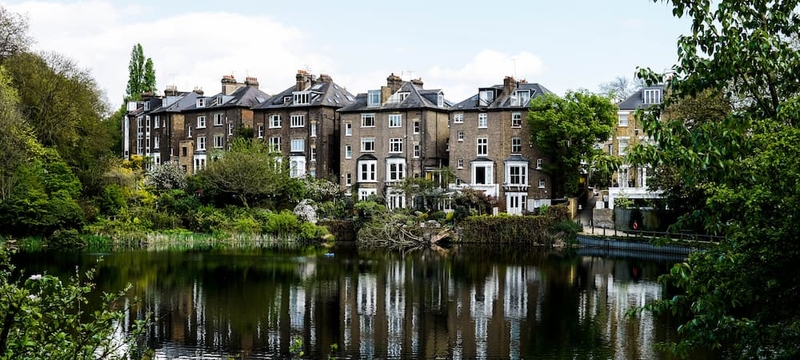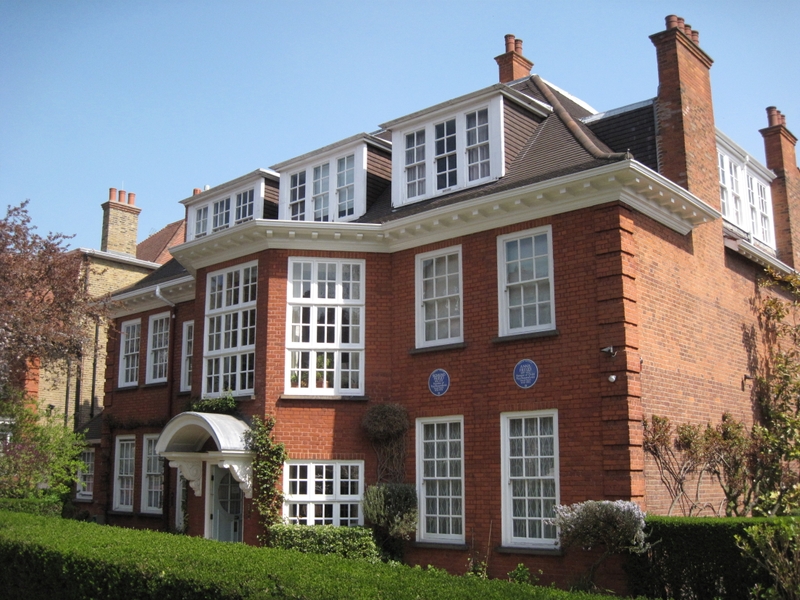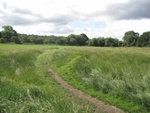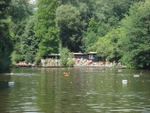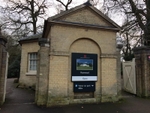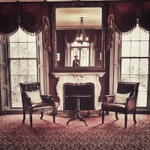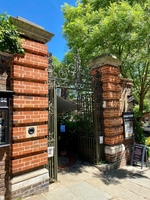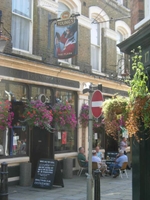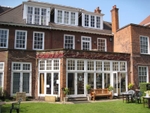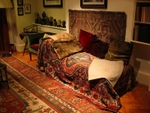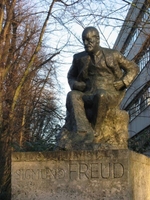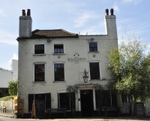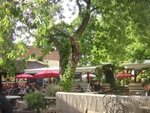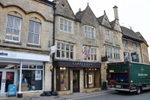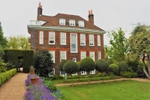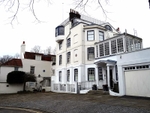1. Hampstead Heath
A trip to Hampstead is not complete without a stroll along the trails of its iconic heath.
The heath is an area of countryside boasting over 800 acres of meadow and woodland, a nature haven within the bustling capital. A walk up Parliament Hill affords visitors spectacular views across London, and is a perfect spot for a picnic too.
Hampstead Heath offers a variety of terrains and vistas. You might opt for a short stroll to take in the Pergola Walk, one of London’s hidden treasures. At the other end of the scale you may opt for the popular circular walk instead, a 6 mile ramble that allows you to experience much of the Heath.
However you choose to spend your day on the heath you will enjoy the scenery which has inspired famous literary figures down the years, such as John Keats and Samuel Taylor Coleridge. This is one of the best parks in London, a green lung which provides a habitat for many UK wildlife species.
2. Outdoor Swimming
Hampstead is an excellent place to enjoy the benefits of open air swimming.
There are three natural swimming ponds located within Hampstead Heath, one assigned for men, one for women, while the third is a mixed swimming pond.
The men’s and women’s ponds are located on the Highgate side of the heath and are fed by the springs of the river Fleet. They are open all year round and have lifeguards on duty, plus shower and changing facilities. The mixed swimming pond is open outside of the winter season and is also lifeguarded. This pond is on the Hampstead side of the heath.
The swimming ponds are quite deep, so less experienced swimmers may prefer the Parliament Hill lido. The lido opens all day long, providing swimmers of all abilities access to its 60 metre open air facility, which includes warm showers, changing rooms and toilets. With adult single day tickets for the ponds and lido priced at just a little over £4, this is a value way to cool off, exercise and have fun all at the same time.
3. Kenwood House
Hampstead has many places of cultural interest, and Kenwood House is another striking example.
Located on the northern edge of Hampstead Heath, the interior architecture of this English Heritage site is worth a visit in itself. Designed in the 18th century by renowned architect Robert Adam, the house is considered a masterpiece, with particular mention to the stunning grandeur of the Great Library.
Kenwood House also has an art collection of the highest calibre. This includes works from such greats as Rembrandt, Van Dyck, Vermeer, Reynolds and Gainsborough. Sculptures, jewellery and furniture form a part of the impressive collection held at Kenwood House. When you have explored the inside of the house and its various collections, you can enjoy a stroll around the 112 acres of parkland which make up the beautiful gardens.
Three carefully restored dairy buildings can be found within these grounds. Kenwood House also has a cafe, garden shop and book shop for visitors.
4. Keats House
John Keats was one of the great romantic poets, who left a remarkable legacy of work for a man who died so young, at just 25 years of age.
Keats House in Hampstead is where the poet lived for a year and a half from 1818. The building was originally called Wentworth Place, but Keats time here was to prove an exceptionally creative period in his brief life.
Keats House provides the opportunity to step back in time and see how the poet lived. Visitors can see many treasures here, including original manuscripts, letters and the books in which Keats wrote his poems. A further personal touch among the artefacts on display is the engagement ring Keats gave his fiancée, Fanny Brawne.
As you walk around this sensitively restored Regency villa, you will get a feel for what inspired Keats as a poet. The house holds events through the year to celebrate and promote poetry and great poets. Make sure you take a stroll around the house gardens where Keats is said to have penned his famous ‘Ode to a Nightingale’
5. Burgh House and Hampstead Museum
Burgh House is a building at the heart of the local community.
Built in 1704, this grade I listed building hosts a diverse range of cultural events designed so visitors can learn about Hampstead and its history. Art exhibitions, talks, concerts and further events are held, with visitors made welcome as they delve in to Hampstead’s heritage.
The first floor of Burgh House hosts the museum. Here you will find an array of artefacts detailing the history of Hampstead, as well as that of Burgh House and some of its former residents. This includes Rudyard Kipling’s daughter, Elsie. There are over 5,000 objects held by the museum, including local documents, furniture, textiles and artworks, all charting the history of the surrounding area.
The house and museum is just a five minute walk from Hampstead underground station, and is open Wednesday, Thursday, Friday and Sunday. Burgh House has a cafe where you can either sit inside or out in the garden.
6. Shopping
If you like independent boutiques, specialist shops and quirky shopping streets, then Hampstead is the place for you.
Brands sit side by side with independent boutiques to offer a range of fashion choices. Clothing and jewellery stores you can find in Hampstead Village include Oliver Bonas Kurt Geiger, Dinny Hall, Hobbs of London and Jigsaw.
Independent delis, bakers, grocers, butchers and assorted food stores line the charming streets, with local and organic produce to the fore. Waterstones and Rymans have stores located in Hampstead, alongside home-ware shops, florists, hair salons, tailors and more.
Flask Walk
Flask Walk is located just off Hampstead high street and is a shopping alleyway full of character. Small, independent shops line this pedestrianised area. A second hand bookshop, garden shop, designer second hand clothes store, jeweller, magic shop and pen shop give you a taste of the eclectic mix along this shopping strip. The Flask pub and Flask Walk cafes will satisfy your food and drink needs too.
7. Freud Museum
Hampstead’s rich history is reflected in the museums located in the area.
One of those is the Freud Museum, the final home of the famed psychoanalysis Sigmund Freud and his daughter Anna. Freud was an avid collector of antiques and the full collection is on display at the museum.
Visitors to the museum can also see the entirety of his personal library, plus notes from his work as well as family photos. Yet what will probably most stick in the memory is a visit to Freud’s study. You have the chance to see the study exactly how it was when Freud worked here. This means it comes replete with the iconic psychoanalytic couch, where his patients would lie and digress their most inner thoughts.
Freud’s daughter Anna lived in the house until her death in 1982, whereupon she bequeathed the house as a museum. Open Wednesday, Saturday and Sunday, the museum offers a fascinating insight to where Freud worked during the latter part of his life. The museum also regularly stages innovative contemporary art exhibitions.
8. Food and Drink
Hampstead offers its visitors a fine choice of food and drink. The following are a few samples among the many excellent options:
The Spaniards Inn
A traditional pub serving stylish, yet authentic British dishes, which can be washed down with a good selection of cask ales and craft beers. This is a pub with a rich history and was featured in the Pickwick Papers by Charles Dickens. Located close to Kenwood House, it is a prime spot to relax after a walk on the heath.
The Fish Cafe
Seafood lovers will enjoy the contemporary menu offered by the Fish Cafe on Hampstead high street. Enjoy traditional fish and chips while sat inside or out, or indulge in a lobster dish, or perhaps a cod or octopus burger. The menu at the Fish Cafe offers a fine choice of dishes, but for an extra little treat you may be tempted by the bottomless oyster and Prosecco brunch offering.
Jin Kichi
Head along to Jin Kichi restaurant on Heath Street for traditional Japanese cuisine. The green facade is easy to spot, while inside you will find a homely atmosphere, with the interior designed around a Robata grill. Further seating can be found upstairs and downstairs, where you can enjoy their sushi, yakitori and a range of grilled fish from the extensive menu. This is a well-established, family run restaurant offering quality cuisine at affordable prices.
The Holly Bush
Another popular, traditional British pub providing quality food and drink. You will find the Holly Bush in Holly Mount, an attractive side street off Holly Hill. Relax in the wood panelled interiors of this grade II listed building and enjoy the range of Fullers ales. With a choice of menus, the Holly Bush prides itself on using fresh, seasonal produce. Their Sunday roasts are regarded as one of the best in the area.
Villa Bianca
Located in Perrins Court, Villa Bianca has been serving high quality Italian cuisine for many years. This is a fine dining experience, ideal for that little treat following a day exploring Hampstead. The extensive menu has a range of pasta, fish and meat dishes, which can be accompanied by their equally extensive and inviting wine list. Booking a reservation is recommended to avoid disappointment.
9. Antique Shopping
Hampstead is a great place to visit if you like shopping for antiques and vintage pieces.
The Hampstead Antique and Craft Emporium is home to over 25 independent stores offering a range of items, including antiques. Located just behind Heath Street and open Tuesday to Sunday, you can wander among the stores, browsing the many antique artefacts, period silverware, vintage clothing, classic jewellery and more.
Another place to search out is Keith Fawkes book shop in Flask Walk. This is a little treasure trove of antique and second hand books. This is an old fashioned book shop in the best possible sense. Books of all descriptions, covering all sorts of topics and niche subjects are just waiting for you to browse and buy.
10. Catto Gallery
The Catto gallery is a prestigious gallery displaying the best in contemporary art.
The gallery has regularly changing exhibitions, bringing you unique works from some of the world’s best contemporary artists. This is a must visit gallery for art lovers, with artists featured including Derek Balmer, John Duffin, Annie Ovenden and Bernhard Vogel.
The gallery features sculptures too, providing a further dimension to the viewing experience. The gallery was established in 1986 and can be found on Heath Street. Open every day of the week, and with new exhibitions every three weeks or so, there is always something new to see.
Further galleries to explore while in Hampstead include Gilden’s art gallery, Clarendon Fine Art, and Zebra One gallery.
11. More things to do in Hampstead
Hampstead has an abundance of places of interest for visitors. Below are a few more worthy mentions:
Pergola & Hill Garden
This hidden gem is tucked away in the North Western corner of Hampstead Heath. The pergola was originally designed to host lavish Edwardian parties, but is now free for the public to wander along. The gardens beneath have been restored and offer a sudden area of cultivation within the heath.
Climbing plants have reclaimed parts of the pergola, adding to the feel of a lost bygone era. This lovely garden is well worth a visit, offering a relaxed walk within a quieter part of the heath.
Fenton House
This National Trust property was built in the 17th century as a merchants house. The house displays many artefacts acquired from one of its previous owners, Lady Katherine Binning. This includes a large collection of porcelain, keyboard instruments and Georgian furniture. The house features much artwork too.
Make sure you step out on to the balcony on the top floor, where you can enjoy great views across London. You can also see initials and dates going back to around the time the house was built carved in to the brickwork. This is a fascinating house, and strolling around the extensive formal gardens completes an enjoyable day out.
Admirals House
Although not open to the public, this is a building which is still worth making a detour to see. It is not difficult to see why this grade II listed building is dubbed the most striking building in Hampstead. Originally built around the turn of the 18th century, the building was home to Lieutenant Fountain North by 1775.
Eccentric is probably the kind term we would use today, as Lieutenant Fountain North added a quarterdeck to the roof. It is said he celebrated famous events and victories by firing cannons, which you can be sure the neighbours fully appreciated! These cannons were mounted on the deck and add to the ship-like appearance of the property. The artist John Constable painted Admiral’s House. Titled ‘Romanic House at Hampstead’, the painting is housed in the National Gallery.
The 1930’s Modernist Home
Hampstead is a fun place to visit for anyone with an appreciation or interest in design and architecture. At 2 Willows Road is a property which was initially controversial but now has its rightful place as a building of interest. It was designed by architect Erno Goldfinger in 1939 as a modern family home.
The property is part of a terrace of three houses, with a distinctive red brick front exterior and a continuous window stretching across the first floor. At the time it was built it looked very modern and people fretted about it looking completely out of place in the area. This was a futuristic vision of house design at the time, and visitors can enter the property which is furnished with original pieces.
